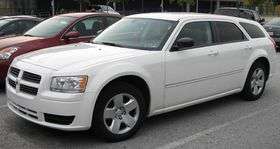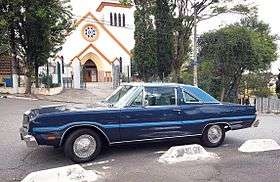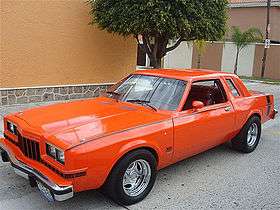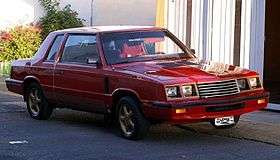Dodge Magnum
The Dodge Magnum is a nameplate used by several Dodge vehicles, at different times and on various markets. The name was first applied to a large Chrysler B platform-based 2-door coupe marketed from 1978 to 1979 sold in the United States[1] and Canada. From the 2005 to the 2008 model years, the nameplate was revived for a station wagon on the rear-wheel drive Chrysler LX platform, produced in Canada and sold on the American and Canadian market.
| Dodge Magnum | |
|---|---|
 2008 Dodge Magnum SE | |
| Overview | |
| Manufacturer | Chrysler Corporation (1978-1988) DaimlerChrysler (2005-2007) Chrysler LLC (2007-2008) |
In Brazil, the Magnum was a top of the line version of the local Dodge Dart, produced from 1979 to 1981.
In Mexico, the Dodge Magnum was a sporty rear-wheel drive two-door car based on Chrysler's M-body (American Dodge Diplomat/Plymouth Gran Fury). From 1983 to 1988 Dodge marketed a sporty two-door K-car as the "Magnum", with an available turbocharger engine from 1984 on.
United States (1978–1979; First Generation)
| United States (1978–1979) | |
|---|---|
.jpg) | |
| Overview | |
| Also called | Dodge XE |
| Model years | 1978–1979 |
| Assembly | Windsor, Canada |
| Body and chassis | |
| Class | Mid-size |
| Body style | 2-door coupe |
| Layout | FR layout |
| Platform | B-body |
| Related | Chrysler 300 (1979) Chrysler Cordoba Dodge Charger Dodge Monaco Plymouth Fury |
| Powertrain | |
| Engine | 318 cu in (5.2 L) LA V8 360 cu in (5.9 L) LA V8 400 cu in (6.6 L) B V8 |
| Transmission | 3-speed A727 automatic |
| Dimensions | |
| Wheelbase | 115.0 in (2,921 mm) |
| Length | 215.7 in (5,479 mm)[2] |
| Width | 77.2 in (1,961 mm) |
| Height | 53.1 in (1,349 mm) |
| Chronology | |
| Predecessor | Dodge Charger |
| Successor | Dodge Mirada |
The Magnum was introduced for 1978 to supplement the Dodge Charger. It was sold in two forms, the "XE" and the "GT" and was the last vehicle to use the long running Chrysler B platform. The appearance was somewhat of a rounded off Charger, and was in response to getting a car that would be eligible for NASCAR that would be more aerodynamic, something that the 1975–1978 Charger was not. Styling features included four rectangular headlights behind retractable clear covers, with narrow opera windows, and an optional T-bar or power sunroof. The Magnum was well-featured with power steering, brakes and seats; the suspension included Chrysler's standard adjustable, longitudinal torsion bars, lower trailing links, and front and rear anti-sway bars. The base engine was the 318 cu in (5.2 L) V8 with Lean-Burn, while two and four-barrel carbureted 360 cu in (5.9 L) and 400 cu in (6.6 L) V8s were optional; weight was nearly 3,900 lb (1,800 kg). During the start of the 1979 model year, the 400 V8 engine was dropped from the options list as Chrysler stopped producing big-block V8 engines in production cars during the end of 1978 model year. A performance model, the "GT" had been available with the 400 cu in (6.6 L) V8 during the previous model year (1978) and the "E58" police interceptor (360 V8-195 HP) engine was available during the 1979 model year along with HD suspension, special axle, special "GT" badging and a "turned metal" dash applique. Technology was advanced for the time with an onboard spark control computer from inception, electronic ignition, and a lockup torque converter. During the end of the 1979 model year, the mid-size B-body Dodge Magnum (along with its mid-size B-body based Chrysler Cordoba counterpart) was discontinued, as was with just the Magnum name itself, in favor of what would become a smaller, all newly designed, M-body platform based Mirada coupe (which also would be shared along with what would become its M-body platform based Chrysler Cordoba coupe counterpart as well) all during the next four model years (1980–1983). Only 3,704 1979 Dodge Magnum coupes included a T-Top.
NASCAR
The mid-size B-body 1978–1979 Dodge Magnum coupe in the United States and Canada was an addition to Chrysler's line up that allowed Richard Petty to continue racing with a Mopar. For the 1978 NASCAR season, the 1974 Charger that Chrysler teams had continued to use was no longer eligible for competition. Chrysler worked on several car designs to smooth out the current 1975 bodied Charger into something that would be reasonably aerodynamic for the big racetracks and the Magnum design was settled on in the summer of 1977 for use in the 1978 racing season. While not as aerodynamic as the 1974 Charger body, the shape of the Magnum showed promise, and the "Petty Enterprises" built test cars reached 190 mph (310 km/h) on test runs. At first it seemed that out on the tracks the cars ran well with Petty almost winning his Daytona 125 (finishing second), and leading over 30 laps of the Daytona 500 until a blown front tire caused him to wreck. However, the lack of factory development support of the small-block Chrysler 360 V8 as a race engine was becoming more of a problem, and in high speed racing traffic the Magnum did not handle well. Petty was particularly harsh in his criticism of the car - before the season he declared, "The Magnum is undriveable at 190 MPH."
By the latter half of the 1978 season, Petty and Neil Bonnett (the two top Mopar teams) gave up on the car's inconsistent performance and switched to Chevrolets and Oldsmobiles, leaving independent drivers Buddy Arrington (who bought a few of Petty's Magnums, along with some parts), Frank Warren, and Country singer Marty Robbins to soldier on without any substantial factory support (Chrysler did provide sheet metal and some engine parts to teams driving Magnums). From August 1978, two to five independent teams showed up with Magnums in NASCAR races, until January 1981, when NASCAR switched to smaller bodied cars. The Magnum never enjoyed the racing heritage of its predecessors, but it was not without its own achievements. Petty scored 7 top five finishes in his 17 races with the car, and Bonnett won three poles and scored 5 top five finishes with his. Petty recognized the Magnum with a commemorative decal, depicting his famous number 43 emblazoned on a Magnum for his 1992 Fan Appreciation Tour. Though Petty never won a race in a Magnum, his son, Kyle Petty drove one of his father's year-old Dodge Magnums in his first race (1979 Daytona ARCA 200), and won. Kyle raced in five NASCAR races using the left-over Magnums in 1979, but wrecked them beyond reasonable repair by the 1980 Daytona 125. As of December 2012, only two NASCAR Magnums still existed; one (an ex-Petty car) resides in the Talladega NASCAR museum, and the other; (Marty Robbins' 1978 Magnum No. 42) has been restored and is owned by a private party in southern California.
Brazil (1979–1981)
| Brazilian Dodge Magnum (1979–1981) | |
|---|---|
 | |
| Overview | |
| Production | 1979–1981 |
| Assembly | São Bernardo do Campo, São Paulo, Brazil |
| Body and chassis | |
| Body style | 2-door coupe |
| Layout | FR layout |
| Platform | A-body |
| Related | Dodge Dart |
| Powertrain | |
| Engine | 318 cu in (5.21 L) LA V8 |
| Transmission | 4-speed manual, 3-speed automatic |
In the old Simca Factory in São Bernardo do Campo, São Paulo, Brazil, the Dodge Dart was produced from 1969 until 1981 (more than 92,000 cars were sold). They were built with minor changes from the original model, starting in 1969, and were all largely based on the 1968 Dart GT (and GTS). For its last three years of production, a two-door upper trim level version of the Dart was sold as the Magnum, featuring the 318 in³ V8 engine used in all Dodge coupe and sedan models in Brazil. A unique fiberglass front fascia that included four headlights to give it a more modern look was used, while the rear end was very similar to the American Dart 1975 (the Dart model from the same year having been identical to the Swinger from USA). The Magnum (top of the line) was sold as a separate model from the Dart (bottom line), despite being technically almost identical to the Dart.
The Dodge was very well received in Brazil. Today one can find car clubs with many Dodge coupes in good condition. The coupe and sedan models in Brazil were (all variations from the Dart 1968 model): Dart [1969–1981] (as a 2-door coupe from 1970 until 1981 or as a four-door sedan from 1969 until 1981), sporting but lower priced Dart SE, better equipped Dart DeLuxo (two or four doors), Gran Coupe (more luxurious yet than the Dart DeLuxo, with two doors only), Gran Sedan (above the Dart DeLuxo model, with four doors only), Charger R/T [1971–1980] (coupe bodywork only, from 1971 to 1980 it was the top model in sport segment), LeBaron (replacing the 'Gran Sedan' with four-door sedan body, from 1979 to 1981) and Magnum (substitute for the 'Gran Coupe', Brazil's top model in the luxurious segment from 1979 to 1981).

Mexico (1981–1988)
| First generation Mexican Dodge Magnum (1981–1982) | |
|---|---|
 | |
| Overview | |
| Production | 1981–1982 |
| Assembly | Toluca, Mexico (Toluca Car Assembly) |
| Body and chassis | |
| Body style | 2-door coupe |
| Layout | FR layout |
| Platform | M-body |
| Related | Dodge Diplomat Plymouth Gran Fury Chrysler LeBaron Plymouth Caravelle Salon |
| Powertrain | |
| Engine | 360 cu in (5.9 L) LA V8 |
| Transmission | 4-speed A833 manual 3-speed A727 automatic |
| Chronology | |
| Predecessor | Dodge Valiant Super Bee |
First generation
In 1980, the F-body cars were discontinued in Mexico, as well in the U.S, so the compact cars Dodge Dart (using the front of the Volaré and the rear of the Aspen), Valiant Volaré (using the front of the Aspen and the rear of the Volaré), and sporty Super Bee, were dropped for this year.
In 1979, Chrysler de México introduced the Chrysler LeBaron based on the M-body platform, and two years later it introduced the Dodge Diplomat as the Dodge Dart. These were very similar to the American Plymouth Gran Fury in appearance and trim, but had Chrysler's Rallye wheels instead of deluxe wheel covers. Chrysler de México used a small platform and the Magnum name, equipping it with 360 CID (5.9L) V8 engine (rated at 300 hp (224 kW), with a Carter ThermoQuad four barrel (four-choke) carburetor), Mopar oil cooler, a 3-speed A727 automatic transmission (A833 4-speed manual optional), heavy-duty suspension, power brakes, stabilizer bars in the front and rear and a Dana 44 differential with positive pass and posi-traction. All the windows and windshield chromed metals were painted flat black; only the bumpers and the grille were chromed. Both the front fascia and the front fenders wore= "Magnum" lettering, with a 5.9L decal on the fenders as well. The Mexican Dodge Magnum was offered only for the 1981–1982 model years.
Second generation
| Second generation Mexican Dodge Magnum 400 / Magnum K (1983–1988) | |
|---|---|
 | |
| Overview | |
| Production | 1983–1988 |
| Assembly | Toluca, Mexico (Toluca Car Assembly) |
| Body and chassis | |
| Body style | 2-door coupe |
| Layout | FF layout |
| Platform | K-body |
| Related | Dodge 400 (U.S.) Plymouth Caravelle K (Canada) Dodge Aries K (U.S.) Plymouth Caravelle (U.S.) |
| Powertrain | |
| Engine | Chrysler SOHC K-Trans-4 engine 2.2L-2.5L I4 Chrysler Turbo SOHC K-Trans-4 engine 2.2L I4 Turbo |
| Transmission | 4-speed manual 5-speed manual 3-speed automatic |
| Chronology | |
| Successor | Chrysler Shadow GTS |
The K-car based Mexican Dodge Magnum was a sporty 2-door compact, based on the Dodge Aries coupe body (with blackout 1982–1985 Dodge 400 grille in 1983–1985 and a blackout 1986–1988 Plymouth Caravelle grille in 1986-1988) offered from 1983 to 1988 with available turbocharger ("TurboChrysler" engine) from 1984 on. Four engines were offered for the Mexican Dodge Magnum K, a SOHC I-4 2.2L (K-Trans-4, 1983–86), a turbocharged SOHC I-4 2.2L (1984–86) and two other 2.5L SOHC I-4s, with and without turbocharger (1987–88). When it was introduced, the Mexican Dodge Magnum 400 Turbo was advertised as "Mexico's fastest car" in the TV commercials of the time, and it surely was in 1985, when the "Fox" (1979–84) 5.0L Mexican Ford Mustang was dropped from the catalog of Ford Mexico. The Mexican front-wheel drive Magnum was officially called "Dodge Magnum 400" between 1983 and 1984, as it was a sporty Mexican variation of the American Dodge 400 of the early eighties (without the vinyl roof of the US version and with high output 2.2L engine (available turbocharger from 1984 on), heavy-duty suspension, sporty wheels, tires, dash, steering wheel, console, shifter and seats). In 1984, the Mexican Magnum 400 Turbo was the closest thing to an American Dodge Daytona Turbo south of the border. For 1985, the "400" suffix was dropped. For the 1987 season, the turbocharger received an intercooler and the power from the turbo engine changed from 140 to 150 hp (112 kW). The K-car based Magnum was replaced by the Mexican Chrysler Shadow GTS for the 1989 model year.
Chrysler LX platform (2005–2008; second generation)
| Dodge Magnum (2004–2008) | |
|---|---|
 | |
| Overview | |
| Production | February 2004–2008[3] |
| Model years | 2005–2008 |
| Assembly | Brampton, Canada |
| Designer | Ralph Gilles (2001) Freeman Thomas (2001) |
| Body and chassis | |
| Class | Full-size |
| Body style | 5-door station wagon |
| Layout | Front engine, rear-wheel drive / four-wheel drive |
| Platform | Chrysler LX platform |
| Related | Chrysler 300 Dodge Charger |
| Powertrain | |
| Engine | 2.7 L (167 cu in) EER V6 3.5 L (215 cu in) EGJ V6 5.7 L (345 cu in) EZB HEMI V8 6.1 L (370 cu in) ESF HEMI V8 |
| Transmission | 4-speed 42RLE automatic 5-speed W5A580 automatic |
| Dimensions | |
| Wheelbase | 120.0 in (3,048 mm) |
| Length | 197.7 in (5,022 mm) |
| Width | 74.1 in (1,882 mm) |
| Height | 2005-07: 58.4 in (1,483 mm) 2008-present: 58.3 in (1,481 mm) SRT8: 57.9 in (1,471 mm) |
| Chronology | |
| Predecessor | Dodge Intrepid |
| Successor | Dodge Journey (FWD/4WD) Dodge Durango (RWD/4WD) |
.jpg)
.jpg)
The Magnum name was revived in 2004 for the 2005 model year, as a station wagon based on the Chrysler LX platform. The new Magnum was a badge engineered station wagon version of the Chrysler 300 manufactured at the same plant in Brampton, Ontario, Canada. The Magnum had four engine options; the SE features the 190 hp 2.72 L LH V6, the SXT had the 250 hp (190 kW) 3.5 L V6, and the RT had the new 340 hp 5.7 L Hemi V8. The SRT-8 has a 425 hp 6.1 L Hemi engine. All-wheel drive became an option in 2005 on SXT and RT models. The SRT8, AWD SXT, and the RT use a Mercedes-Benz-derived 5-speed automatic transmission, while all other models use a four-speed automatic. The Magnum was built at the Brampton Assembly Plant, near Toronto, Ontario, Canada, from 2004 to the end of model year 2008.[4]
The Magnum was on Car and Driver's Ten Best list for 2005.[5]
SRT-8
Production numbers for the SRT-8.
2006–2,970
2007–921
2008–239
A high performance SRT-8 version debuted at the 2005 Los Angeles Auto Show. The SRT-8 was based on a concept car that was displayed at the 2003 Los Angeles Auto Show.[6] It went on sale in 2005 as a 2006 model. Like the 300C SRT-8, it featured the new 6.1 L (370 cu in) Hemi engine, which produces 425 hp (317 kW). 20-inch wheels, firmer suspension, bigger brakes (Brembo), new lower-body treatment, and a revised front and rear-fascia completes the transformation. The SRT-8 was named Best New Modern Muscle Car in the 2006 Canadian Car of the Year contest.
Motor Trend Test Results:[7]
- 0-60 mph: 5.1 sec
- 0-100 mph: 11.7 sec
- Standing 1/4-mile: 13.1 sec @ 108 mph (174 km/h)
Europe and Australia
In Europe and Australia, the Magnum was sold as the Chrysler 300 Touring. It was essentially the same as the U.S.-market Magnum, but with the Chrysler 300C's front end and interior, and right-hand-drive for Australia and the U.K. The 300C Touring added an available 3.0 L CRD Turbo Diesel version. The 300C Touring was assembled in Austria.
2008 changes
For the 2008 model year, the Magnum received a facelift as well as an updated interior in line with that of the Dodge Charger. The front fascia sported new aggressively squared off headlights and a smaller rectangular grille more reminiscent of the Charger. The SRT-8 variant gained a new hood scoop. A new bright red paint scheme was introduced. The new changes brought the car closer to its Charger platform mate, away from the Chrysler 300.[8]
Cancellation
On November 1, 2007, Chrysler announced that, as part of its restructuring plans, the Dodge Magnum would be one of four models discontinued after the 2008 model year. In Chrysler's words: "The Magnum, along with the PT Cruiser convertible, the Crossfire, and the Pacifica were not earning their keep". Production ended on March 28, 2008. The Dodge Magnum (along with the short-wheelbase Dodge Caravan) has been replaced by the Dodge Journey.[4]
Total U.S. sales
| Calendar Year | Sales |
|---|---|
| 2004[9] | 39,217 |
| 2005[9] | 52,487 |
| 2006[10] | 40,095 |
| 2007[10] | 30,256 |
| 2008[11] | 6,912 |
| 2009[12] | 113 |
References
- Chrysler brochures: Chrysler de México 1981-88
- "1979 Dodge Magnum XE specs". Carfolio.com. Retrieved 2010-09-29.
- http://media.fcanorthamerica.com/pdf.do/3Fid/3D10242&ved=2ahUKEwjQ0sio54XZAhUFgK0KHeXVCSMQFjANegQIAhAB&usg=AOvVaw1qAJ-3dv587Y5XdLcDV7mx
- Dee-Ann Durbin (AP) (2007). "Chrysler to cut up to 12,000 jobs". Yahoo News. Archived from the original on November 3, 2007. Retrieved November 1, 2007.
- "CNNMoney.com: Car and Driver names 10 best cars". Money.cnn.com. 2004-12-14. Retrieved 2010-09-29.
- "Dodge Magnum SRT-8". www.ultimatecarpage.com. Retrieved 26 December 2012.
- "Motor Trend Comparison Test: Dodge Magnum SRT-8". Motortrend.com. 2007-02-26. Archived from the original on August 24, 2010. Retrieved 2010-09-29.
- "Automobile Magazine: 2008 Dodge Magnum". Automobilemag.com. Retrieved 2010-09-29.
- "Chrysler Group 2005 US Sales". Chrysler. 2008-01-03. Archived from the original on January 21, 2009. Retrieved 2009-01-05.
- "Total Chrysler LLC December 2007 Sales Up 1 Percent on the Strength of Retail". CheersandGears.com. 2008-01-03. Retrieved 2009-01-05.
- "December 2008 Sales: Chrysler LLC". CheersandGears.com. 2009-01-05. Retrieved 2009-01-05.
- "Chrysler Group LLC December 2009 Sales". CheersandGears.com. 2010-01-05. Retrieved 2010-01-05.
External links
| Wikimedia Commons has media related to Dodge Magnum. |
- Marty Robbins #42 Dodge Magnum
- Original Dodge Magnum and 2005-current Dodge Magnum at allpar.com
- 2005-current Dodge Magnum R/T
- Chrysler 300C Touring (Australia)
- The Last 2008 Magnum SRT-8 Steel Blue car 29 Claude Lacombe's 2008 Dodge Magnum SRT8